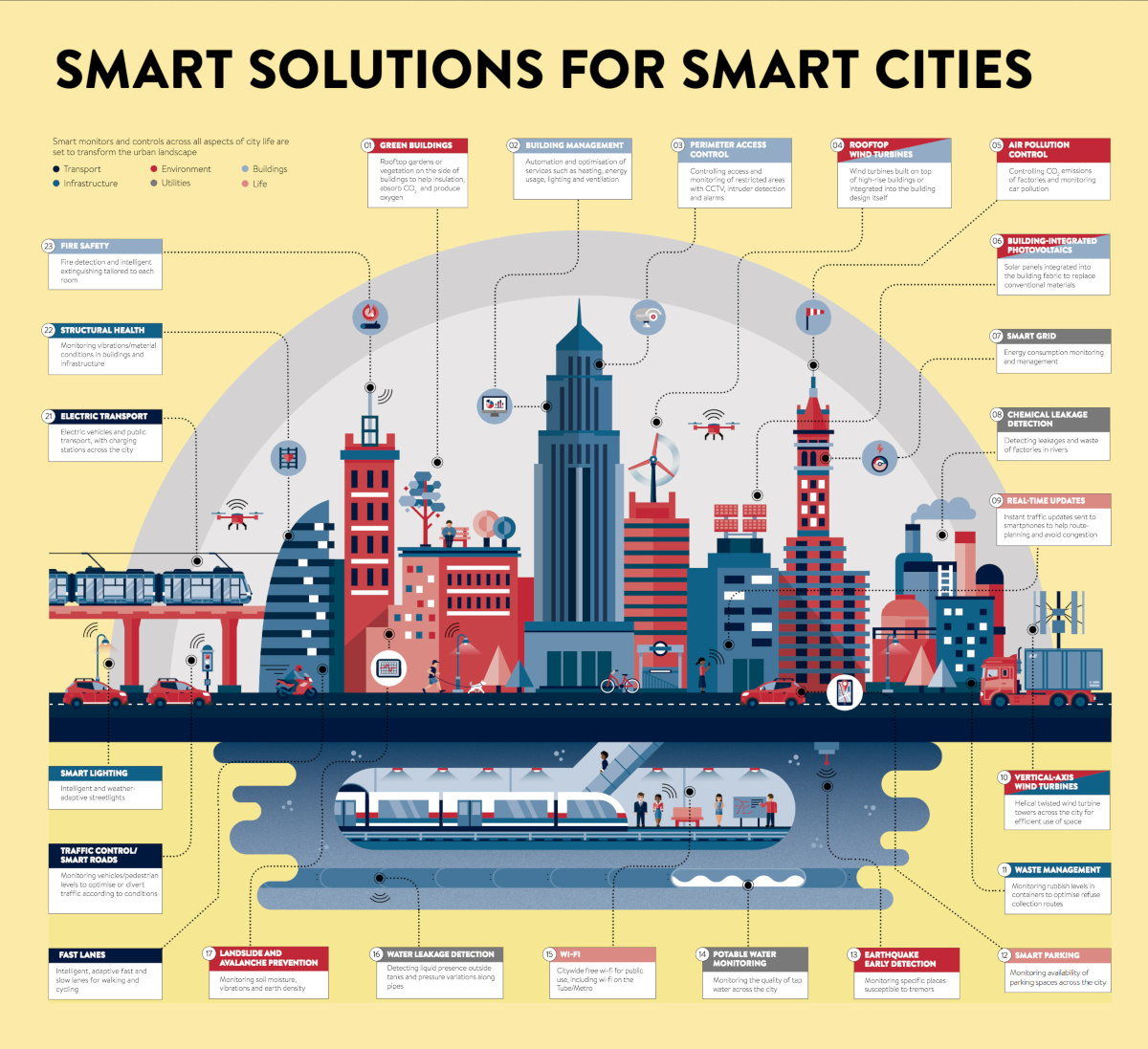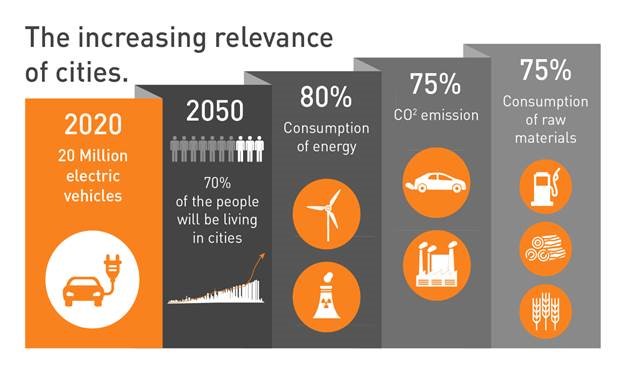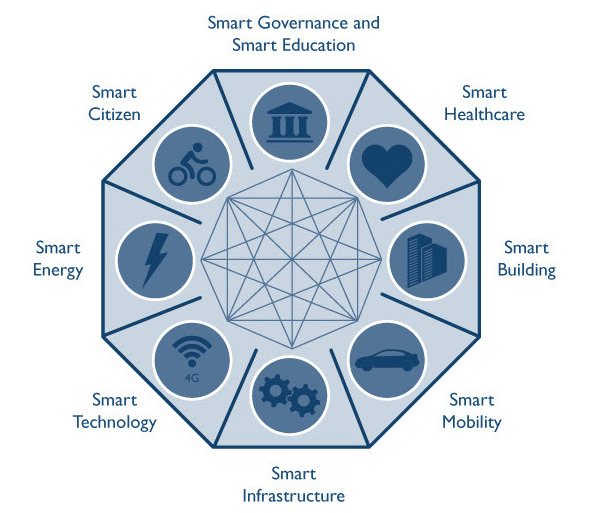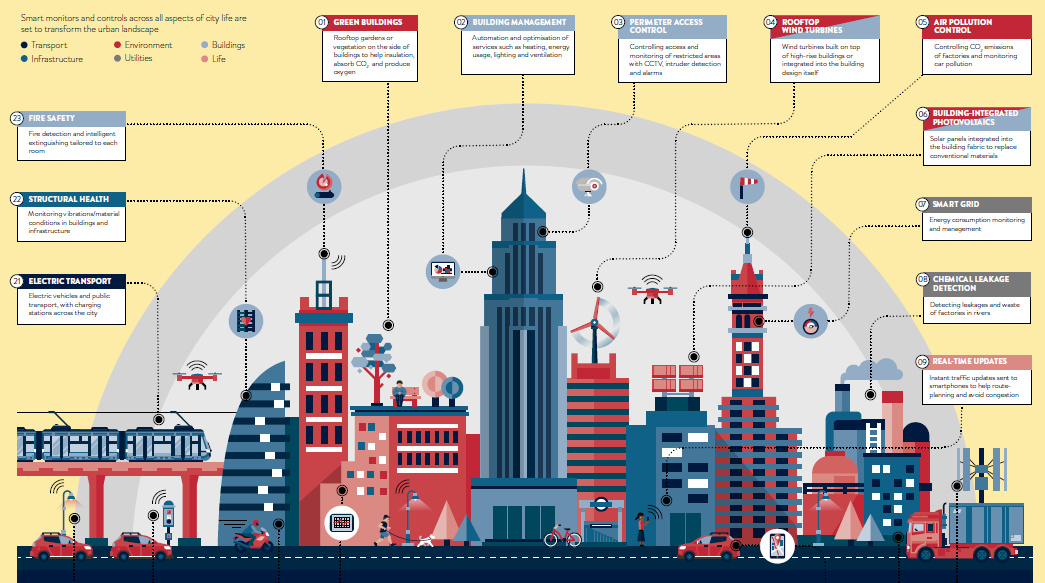Technology
How the World’s Smartest Cities are Being Built
View a high resolution version of this graphic

How the World’s Smartest Cities are Being Built
View the high resolution version of today’s graphic by clicking here.
As the world’s biggest cities continue to sprawl with many millions of new people, they’ll look to many of the technologies and tactics covered in today’s infographic from Raconteur to work smarter – and not harder – for their inhabitants.
Why Cities?
Cities are the engines of modern society.
They power the global economy, consume vast amounts of resources, house the majority of the world’s population, and create much of the pollution and emissions that have scientists concerned about the future.

And while big cities consume a lot of resources already – this hardly compares to the megacities of the near-future. In fact, in our lifetimes, we will see massive urban areas in Africa and Asia with populations that swell to 50 million people or more.
That’s right – there will be swelling urban populations that consume more food, energy, and materials than most countries.
The Right Timing
While the prospect of optimizing for the problems of burgeoning metropolises may seem daunting, the timing is actually perfect. The arrival of the Internet of Things (IoT) – thanks to innovations in cheap sensor technology, big data, and predictive analytics – is making it possible to tackle all sorts of urban issues.
Integrating this, along with other advancements in information communication technology (ICT), into urban planning is the vision for smart cities:

But, enough on the broad strokes of this movement – here’s how specific changes are taking place.
Working Smarter, Not Harder
Here are some of the initiatives taken on by the people running the smartest cities today:
Smart roads
Monitoring vehicle and pedestrian levels to optimize or divert traffic according to conditions. Intelligent, adaptive fast and slow lanes for walking and cycling.
Smart buildings
Rooftop gardens or vegetation on sides of buildings to help with insulation. Optimization of heating, energy usage, lighting, and ventilation. Integrating photovoltaics and wind turbines into building designs.
Smart lighting
Intelligent and weather adaptive street lights to boost energy efficiency.
Smart waste management
Monitoring garbage levels in containers in real-time to optimize collection routes.
Smart grids
Energy consumption monitoring and management. Uses tech to detect and react to local changes in usage.
And cities aren’t the only thing becoming smarter. See how the home is becoming smarter, as well.
Technology
Ranked: Semiconductor Companies by Industry Revenue Share
Nvidia is coming for Intel’s crown. Samsung is losing ground. AI is transforming the space. We break down revenue for semiconductor companies.
Semiconductor Companies by Industry Revenue Share
This was originally posted on our Voronoi app. Download the app for free on Apple or Android and discover incredible data-driven charts from a variety of trusted sources.
Did you know that some computer chips are now retailing for the price of a new BMW?
As computers invade nearly every sphere of life, so too have the chips that power them, raising the revenues of the businesses dedicated to designing them.
But how did various chipmakers measure against each other last year?
We rank the biggest semiconductor companies by their percentage share of the industry’s revenues in 2023, using data from Omdia research.
Which Chip Company Made the Most Money in 2023?
Market leader and industry-defining veteran Intel still holds the crown for the most revenue in the sector, crossing $50 billion in 2023, or 10% of the broader industry’s topline.
All is not well at Intel, however, with the company’s stock price down over 20% year-to-date after it revealed billion-dollar losses in its foundry business.
| Rank | Company | 2023 Revenue | % of Industry Revenue |
|---|---|---|---|
| 1 | Intel | $51B | 9.4% |
| 2 | NVIDIA | $49B | 9.0% |
| 3 | Samsung Electronics | $44B | 8.1% |
| 4 | Qualcomm | $31B | 5.7% |
| 5 | Broadcom | $28B | 5.2% |
| 6 | SK Hynix | $24B | 4.4% |
| 7 | AMD | $22B | 4.1% |
| 8 | Apple | $19B | 3.4% |
| 9 | Infineon Tech | $17B | 3.2% |
| 10 | STMicroelectronics | $17B | 3.2% |
| 11 | Texas Instruments | $17B | 3.1% |
| 12 | Micron Technology | $16B | 2.9% |
| 13 | MediaTek | $14B | 2.6% |
| 14 | NXP | $13B | 2.4% |
| 15 | Analog Devices | $12B | 2.2% |
| 16 | Renesas Electronics Corporation | $11B | 1.9% |
| 17 | Sony Semiconductor Solutions Corporation | $10B | 1.9% |
| 18 | Microchip Technology | $8B | 1.5% |
| 19 | Onsemi | $8B | 1.4% |
| 20 | KIOXIA Corporation | $7B | 1.3% |
| N/A | Others | $126B | 23.2% |
| N/A | Total | $545B | 100% |
Note: Figures are rounded. Totals and percentages may not sum to 100.
Meanwhile, Nvidia is very close to overtaking Intel, after declaring $49 billion of topline revenue for 2023. This is more than double its 2022 revenue ($21 billion), increasing its share of industry revenues to 9%.
Nvidia’s meteoric rise has gotten a huge thumbs-up from investors. It became a trillion dollar stock last year, and broke the single-day gain record for market capitalization this year.
Other chipmakers haven’t been as successful. Out of the top 20 semiconductor companies by revenue, 12 did not match their 2022 revenues, including big names like Intel, Samsung, and AMD.
The Many Different Types of Chipmakers
All of these companies may belong to the same industry, but they don’t focus on the same niche.
According to Investopedia, there are four major types of chips, depending on their functionality: microprocessors, memory chips, standard chips, and complex systems on a chip.
Nvidia’s core business was once GPUs for computers (graphics processing units), but in recent years this has drastically shifted towards microprocessors for analytics and AI.
These specialized chips seem to be where the majority of growth is occurring within the sector. For example, companies that are largely in the memory segment—Samsung, SK Hynix, and Micron Technology—saw peak revenues in the mid-2010s.
-

 Real Estate2 weeks ago
Real Estate2 weeks agoVisualizing America’s Shortage of Affordable Homes
-

 Technology1 week ago
Technology1 week agoRanked: Semiconductor Companies by Industry Revenue Share
-

 Money1 week ago
Money1 week agoWhich States Have the Highest Minimum Wage in America?
-

 Real Estate1 week ago
Real Estate1 week agoRanked: The Most Valuable Housing Markets in America
-

 Business2 weeks ago
Business2 weeks agoCharted: Big Four Market Share by S&P 500 Audits
-

 AI2 weeks ago
AI2 weeks agoThe Stock Performance of U.S. Chipmakers So Far in 2024
-

 Misc2 weeks ago
Misc2 weeks agoAlmost Every EV Stock is Down After Q1 2024
-

 Money2 weeks ago
Money2 weeks agoWhere Does One U.S. Tax Dollar Go?














